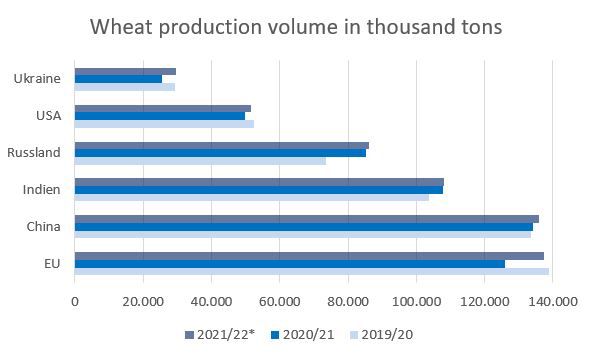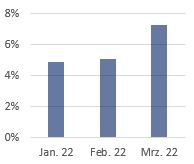The Covid-19 crisis and the resulting fundamental changes in global supply and production chains caused a serious existential risk to many companies with a commodity-based focus. The steep rise in commodity and energy prices since October 2021 is equally central to corporate risk management. This article is intended to shed light on the current situation for agricultural enterprises.
Since the beginning of the conflict between Russia and Ukraine, global political and economic uncertainties have also been reflected in the commodity prices. Mainly, there is a price increase for fertilizer, corn, soybeans, sunflower seeds and wheat. Since Ukraine and Russia are among the leading global wheat exporters (Fig.2), price volatility is particularly noticeable for wheat. (Fig. 1)
Fig. 1: Development of the wheat price on CBOT and daily percentage change since 1 February 2022

Source: KPMG AG, based on Reuters-Martkdaten
Fig. 2: Development of wheat production volumes for the years 2019/2020 to 2021/2022.

Source: www.statista.com
Ralph Schilling
Partner, Financial Services, Head of Finance and Treasury Management
KPMG AG Wirtschaftsprüfungsgesellschaft
The current price level not only poses major challenges to agricultural operations, commodity traders and manufacturing companies in terms of the interplay between procurement, production and distribution, but also poses the risk of hunger and supply shortages within emerging and developing countries in Africa, which are the largest buyers of Ukrainian and Russian grain exports.
Of supply bottlenecks, rising inflation and consumer prices
Since the beginning of the Russia-Ukraine conflict, exports of agricultural commodities have plummeted, as expected. The fields can only be cultivated at great risk, and the export of raw materials by sea and land is almost impossible for Ukraine. As a result, the procurement of otherwise highly demanded raw materials such as wheat, corn, sunflower oil from Russia and Ukraine, especially for North and West African countries, the Middle East, but also European agricultural companies, suffers from supply shortages or high prices. Additionally, the prices of important production factors such as seeds and fertilizers are coming under pressure due to the increase in energy prices for electricity, oil and gas at the same time.
The increase in procurement costs has a direct impact on the cost of basic food and processed products. In addition, there are long waiting times for goods due to slowed supply chains, which poses challenges especially for farmers who rely on animal food, fertilizer and similar goods needed for animal farming. However, the impact of supply shortages is also felt on the producer side and in the food industry. Retailers are already seeing the impact through partially empty shelves. As a result, retailers are responding to the increased procurement costs, often by passing them on to end consumers (see Fig. 4). The result? A significant contributor to the already existing inflation. (See Fig. 3 for the current inflation)
Fig. 3: Inflation rate in Germany in the last three months

Source: KPMG AG, based on Reuters-Martkdaten
Fig. 4: Development of the Harmonized Index of Consumer Prices in Germany (HICP) over the past 2 years

Source: KPMG AG, based on Reuters-Martkdaten
Economists believe that inflation is likely to rise to a value of at least 4% by the end of the year. Also, according to the BGA1, higher levels of producer prices can be expected in Europe in the long run. Analysts and economists disagree on whether the current development is a direct consequence of the Russia-Ukraine conflict or a long-term trend.
The passing-through of market price change risk
"No manufacturer can survive without passing on dramatically rising costs," is how Lorenz's CEO describes the current handling of market price risk.
Currently, the food industry and the stationary retail trade are particularly affected by the high procurement prices, which they have to pass on to the customer in order to stabilize their trade margins. As a result, the prices of basic foods have risen successively across the board. Even the discounters' and supermarkets' own brands, which are otherwise affordable and price-stable, had to be marked up due to the current raw material, energy and logistics prices. However, market price risk cannot be passed on in all industries. The latest example of this is the case of a supplier who has concluded a multi-year supply contract or cooperation agreement with the stationary retail trade. This could involve, for example, a meat production company and one or more retail chains. The producer is exposed to market price risk without appropriate price hedging by means of fixed price contracts or derivatives on the procurement side. During the bid phase, prices for the sale of the goods produced are fixed on the sales side. However, on the procurement side, there is usually little or no price fixing for the required commodities until the start of production. As a consequence, in this example, meat production is completely exposed to the risk of a temporary increase in the meat prices with high price volatility, due to the increased feed costs. Furthermore, the increased energy prices have an impact, which puts further pressure on the already reduced margin due to the increased raw material prices , or even completely wipes it out, with the result that going concern is at risk with the current supply chains and market conditions without previously taken hedging measures. Such an example can be applied to other sectors within the commodity-intensive industry.
Mitigate procurement and sales-side risk
In many cases, companies in the commodity-intensive industry and commodity trading are faced with the challenge that they are usually not in a position to properly determine their exposure from open positions on the procurement and sales side. The reason for this is usually a heterogeneous data and system landscape, which makes it difficult to measure and collect exposure in a uniform and centralized manner. While this may not pose a major risk in a laterally trending market, the situation may be different in times of highly volatile commodity prices. The current market situation has once again given companies reason to question the appropriateness of previous risk management strategies, methods and processes and the design of the risk cycle in trading and treasury with regard to the ability to sustainably manage uncertainties.
Companies have several alternative courses of action for dealing with volatile commodity prices in the long term:
- Risk strategy and risk KPIs
Be sure to check whether your current risk strategy matches your corporate targets and whether the significance of relevant risks (market, credit and liquidity risks) are known to your company. Verify that the current indicators of risk allow a reliable statement on the impact on the company-specific performance indicators (EBIT, cash, equity ratio) according to which the company is managed. It is best to define a clear risk management strategy. - Exposure survey
Review the level and emergence points of your commodity risk. Get an overview of which transaction types should be included in your exposure and/or your hedges (physical stocks, physical delivery contracts, financial contracts, time buckets, delivery points, etc.). In doing so, it is also a good idea to consider to what extent and with what delay the risks can be passed on, for instance, because a risk is overestimated because only a commodity’s purchasing price is looked at without considering how sales prices react to changes in the commodity markets. - Risk capacity
Define which risk you are ready to bear in this strategic area. Be sure to choose an appropriate methodology to measure and report risk. Decide on which risks you may enter into with the help of a risk/reward profile. In doing so, you may want to differentiate between a threshold for times of normal business activity and a different threshold for extreme scenario. - Hedging strategy
Hedging strategies should be formulated in consideration of your goals when purchasing commodities. Is there a possibility to trade for own account or to enter into positions using a market-timing strategy? Define the methodology used to measure the success of your hedging strategy (e.g. benchmarking) and perform it regularly. Make sure the hedge’s effectiveness remains intact from both an economic and an accounting point of view, taking into account the current market situation (e.g. effectiveness of proxy hedges). - Framework conditions for commodity trading
It is important to create a clear governance structure, which enables the definition of framework conditions for commodity trading and clearly governs responsibilities. For this, identify who is entitled to change the existing framework conditions and whether it is possible to override the adherence to these rules. Define which products/instruments are permitted for trading.
The past few months have once again shown that it may well be useful to demonstrate to management and cost controlling the need for and benefits of an effective and comprehensive risk management for market price risk. Therefore: Be prepared in good time for the next extreme events and develop safeguards to protect yourself against any future turbulence.
Your Finance and Treasury Management team will be happy to discuss any questions you may have.
Source: KPMG Corporate Treasury News, Ausgabe 120, April 2022
Authors:
Ralph Schilling, CFA, Partner, Head of Finance and Treasury Mangement, KPMG AG
Moritz zu Putlitz, Manager, Finance and Treasury Management, KPMG AG
__________________________________________________________________________________________________________________________________________________________
1 Bundesverband Grosshandel, Aussenhandel, Dienstleistungen e.V. (German Association of Wholesale, Foreign Trade, Services e. V.; BGA)


